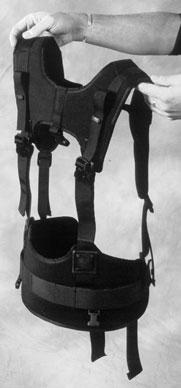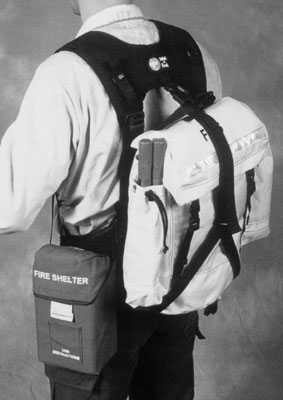
Bill Kilroy Engineering Technician
George Jackson Program Leader
The yellow field pack (NFES No. 1372) can be upgraded with a new harness system (figure 1) that improves the load-carrying capabilities of the field pack system. All yellow field packs can be quickly and easily upgraded with this new harness to turn the system into a comfortable, modular, lower lumbar pack design. Simply replace the current field pack harness (NFES No. 1557) and the field pack belt (NFES No. 1530) with the new harness system. No modifications are required. The retrofit harness is a quick and economical way to improve the current inventory of field packs.


Figure 1—The retrofit harness (front view left, and back view) for
the field pack system will allow firefighters to cary their gear
more comfortably.
This new harness design was a collaboration by Ron Friedrich and Jim Nielson. Their company, What on Earth Wildland Gear (11504 170 St. NW.; Edmonton, AB T5S-1J7; phone: 780–455–5757) has been designing web gear and harnesses for industry, firefighting, and general outdoor recreation for over 10 years. Ron and Jim decided to improve the yellow field pack system after listening to comments by wildland firefighters from Saskatchewan.
The retrofit harness is a linked two-piece system. The first component is a waist belt that acts as a back support, transferring the load to the hips to reduce fatigue. The second part of the system is a yoke assembly that is curved to fit the upper torso. The two components are linked by bands that adjust for torso length and body shape. Whether it is worn during line construction or walking, the system is lightweight, rugged, and comfortable. Accessory lash points allow the user to customize the system and add carrying options. The harness is designed to carry all of the modular field pack components, including the main pack, belt pack, canteen cases, and either the standard fire shelter or the newly released new generation shelter (figures 2 and 3).

Figure 2—The retrofit harness with the field
pack main pack (NFES No. 1559).

Figure 3—The retrofit harness with the field
pack belt pack (NFES No. 0590).
Most agencies have a large inventory of field packs. The retrofit harness is an economical way to convert the modular components of the field pack into a modern lower lumbar load-carrying system, extending the service life of the field pack and providing wildland firefighters with an improved piece of load-carrying equipment.
The retrofit harness will be available soon through the General Services Administration Federal supply schedules.
About the AuthorsBill Kilroy has a bachelor's degree from Montana State University, Bozeman, MT, and has done graduate work at Golden Gate University, San Francisco, and at the University of Montana in Missoula, MT. He began his Forest Service career as an engineering draftsman at MTDC in 1980 and has worked on many of the center's projects since then. He is the Forest Service's COMSEC custodian, coordinating the use of GPS receivers that have been encoded with military codes for increased accuracy.
George Jackson has been part of the Forest Service's fire and aviation program since he began working on a district fire crew for the Lolo National Forest in 1970. From 1974 to 1991, he was a smokejumper at the Missoula smokejumper base. During the winters he was detailed to MTDC where he worked on fire and aviation projects. He has been a project leader at MTDC since 1991. In addition to project work, he is an air tactical group supervisor and has served on many wildland fire entrapment and fatality investigations.
Additional single copies of this document may be ordered from:
USDA FS, Missoula Technology and Development Center
5785 Hwy. 10 West
Missoula, MT 59808–9361
Phone: 406–329–3978
Fax: 406–329–3719
E-mail: wo_mtdc_pubs@fs.fed.us
Electronic copies of MTDC's documents are available on the Internet at:
Forest Service and Bureau of Land Management employees can search a more complete collection of MTDC's documents, CDs, DVDs, and videos on their internal computer networks at:

